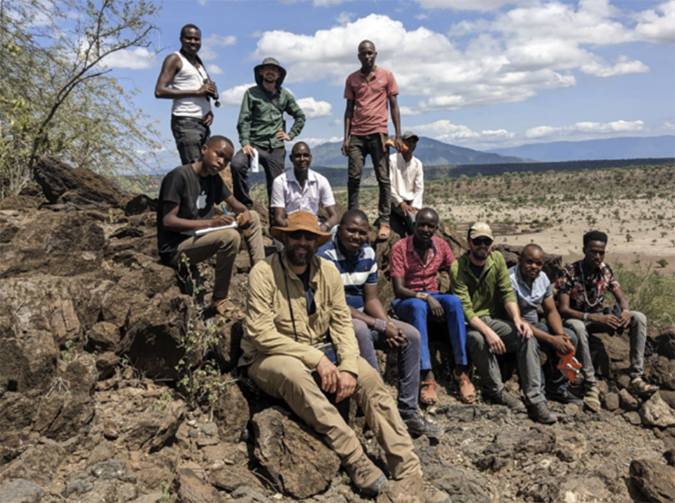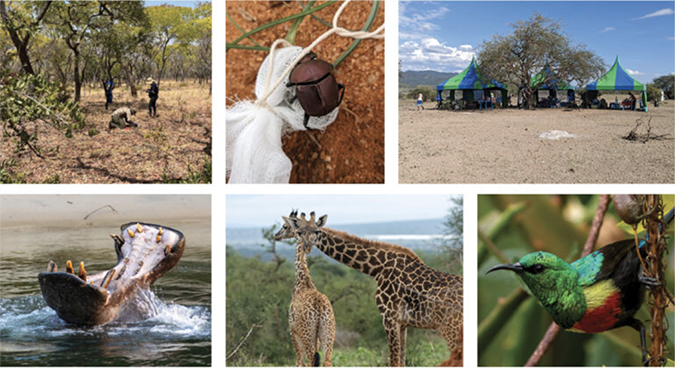| |
Heroes in the Wild
Ed Jenkins – Paving New Paths in the Wild
by Biodiversity Research Institute (BRI)
Published January 3, 2024

The biodiversity survey team takes a short break in the intense heat of Kenya’s Great Rift Valley. BRI scientists Chris Persico (front, left), Mark Burton (front, third from right), and Ed Jenkins (back, second from left) worked closely with Maasai wildlife experts including Denis Parmeres (middle, left) and Lankas Ole Noi (back, right) as well as local leaders and community members to conduct effective surveys in the area. |
BYLINE: By Deborah McKew, BRI Communications Director
Newswise — Two things stand out when you walk into Ed Jenkin’s office: he always offers a welcoming smile, and once you acknowledge him, your eyes are drawn to the beautifully curated, vibrant artwork on his walls—photographs he has taken of the many species of birds and the variety of landscapes where he has studied these birds around the globe.
Ed has always been interested in birds; he can’t even remember the first time that spark ignited. “For me it was pre-memory, as just this very young child. We traveled a lot and my parents always had binoculars and bird books with them. I think it ingrained before I even remember it.”
Once he realized that watching and studying birds could be a vocation, he pursued a career in science. His interests allowed him to travel the world, studying Red-winged Fairy-wrens in Australia, researching Black-throated and Silver-throated Tits in China, and working with migratory birds in the Arava Desert of Israel.

Top row left to right: Field work in Africa can be tedious, such as hunting for and cataloging dung beetles, an important bioindicator for ecosystem health. The accommodations are sparse, such as this camp located in the arid surroundings of Lake Magadi, the southernmost lake in Kenya's Great Rift Valley. Bottom row left to right: A hippopotamus reminds us of the dangers in the wild; The reticulated giraffe shown here is one of four species of giraffes; the Beautiful Sunbird is a common resident of the scrub savanna of Kajiado County, Kenya. Photos © BRI-Ed Jenkins |
His adventurous path led him to BRI, first as a volunteer then as a full-time avian biologist. His talents are a great asset to BRI’s River Point Bird Observatory for which he helps manage bird banding operations in Maine. It wasn’t long before his wide range of skills and experiences were requested by BRI’s other programs, for both fieldwork and data analysis.
But the travel bug kept Ed looking to pursue new opportunities. “As soon as biodiversity surveys in Africa were being discussed, I felt strongly that I should be a part of that work.”
He continued to follow progress on BRI’s various international projects, and when there was a need for someone with his expertise, he was ready. In early 2023, Ed became the International Research Lead, a position he helped define. “I’m now playing a role in many of our international projects, especially those relating to birds and bird conservation,” Ed says with that big smile of his.
In 2023, Ed traveled to Indonesia to study the impacts of mercury on wildlife and human health, and to Kenya and Zambia to conduct biodiversity surveys as part of soil carbon sequestration projects in Africa. His responsibilities include overseeing data collection, developing study designs, refining protocols, and perhaps most importantly, building relationships with local partners.
“I spend much of my time coordinating with those groups, identifying experts in the field, trying to bring people together.” These relationships are critical to the success of BRI’s international projects. Ed’s calm demeanor and deep understanding of different cultures makes him an ideal person for this job.
Ed’s responsibilities at BRI also include roles as the director of the Wildlife Forensics Lab and co-lead of the Acoustics Lab. When he is not traveling the world, he continues to support BRI’s research centers and programs with his expertise in avian ecology. His office is getting crowded with all the new photographs from his travels—lucky for those of us who get to admire them.
|

